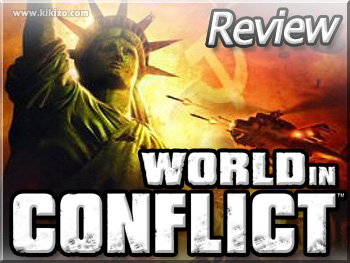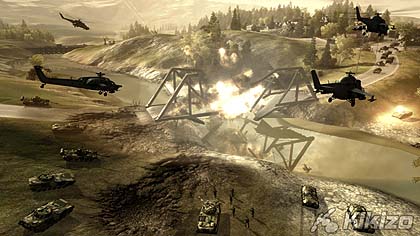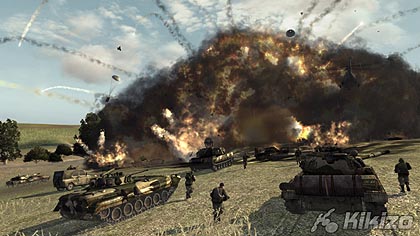World in Conflict
Certainly one of the best PC releases this year.
| Version PC, Xbox 360 | Developer Massive Entertainment | Publisher Sierra / Vivendi | Genre RTS |
||||
I was too young to understand how scared people were of the Cold War - how the possibility of nuclear annihilation was genuinely looming overhead. All I have are vague memories from youth of a rubbish country with no money trying to make friends with everyone, then changing its name. Oh, and CCCP football shirts, which - bar the trendy bellends ruining them in an 'ironic' sense out there - are still pretty damn funky. And that splodge on Gorbachev's head. And how drunk Yeltsin was (though I suppose that was post-Cold War).

The point being made is that I never saw why people were scared during the Cold War - compared to other wars it seemed a bit crap. There were no incredible and unjustifiable losses of life, no frontline war reports, nothing you would see in a 'normal' war. Not that war is good in any way, shape or form, don't get me wrong here, but a child growing up with stories of how scared people were simply cannot grasp the concept; especially not when he has a Grandfather who was a POW in the Second World War - that was scary. But still the people were scared, and it eventually dawned on me through the years. There was a real menace hanging around in the air - Cold War-era movies helped me grasp this concept (Red Dawn YEAH! Ahem...), and thinking about it, I'd be quite scared of nuclear obliteration. I'm only human, after all.
This long-winded and tangential intro brings us fairly nicely towards the point at hand - World in Conflict. In it, the fears of the public are played out in an alternate history setting - it's 1989, World War III has broken out between the USSR and, well, everyone else and to make things that little bit more irritating, the damn Commies have gone and launched a surprise invasion of the US. Things have gone, as a great philosopher once noted, 'a bit tits up'. What we are left with is the ability to repel those darn Ruskies through a number of real-time strategy missions, though maybe not as we're used to here in Amaze-O-PC-Land.
Gone is the standard base-building nonsense, replaced by a streamlined and far more satisfying system - reinforcements are simply airdropped in the field, as and when they are needed. Each unit is paid for using a points system which works intelligently enough: you are assigned a certain amount from the beginning of a mission, this number can be raised by carrying out both primary and secondary objectives and when a unit is lost, the points spent to purchase it are returned to the reinforcement bank, though only over a period of time. It's simple, it works. It also brings in a whole host more strategy than one might be used to with recent efforts such as (the wonderful) Command and Conquer 3 - you cannot simply build up an army capable of blowing up the sun in under a second, and so have to rely on your wits and tactical know-how to get through many situations. Blunt force will obviously carry you through wherever it can, but other aspects have to be taken into account - anti air units to protect your troops from skies, infantry to take out those irritating anti-tank soldiers, scouts to spot for the artillery and so on. It isn't as deep as one would initially think, but the rock-paper-scissors element at least keeps you constantly thinking.
The other main non-standard element comes in the shape of Fire Support - which really is as satisfying as it sounds. Working on a similar points system to the reinforcements, Fire Support lets you take out your frustrations on the Reds with a number of artillery barrages, air strikes and bunker busters, leading to weapons such as Daisy Cutters (made famous in everybody's favourite Gulf War II!) and tactical nuclear strikes - the last of which is used in a surprisingly tasteful way, if that is the correct choice of words - it isn't merely 'another bomb', it is a weapon of mass destruction, and one that brings more bad than good. This is made clear to the player, but when they are necessary, they really are. The tactical implications of these weapons cannot be understated, and missions can be won and lost by using artillery strikes a second earlier or a second too late. It really is quite thrilling.
The campaign takes place through the US, Europe and Russia and takes players through the story in that wonderful post-modern backwards-forwards-backwards-backwards-forwards chronology that seems so cool to people that watch Tarantino movies. And who am I to complain if it works perfectly fine here? You think you're never going to find out what happened in Europe to all these veterans, but you will. Which is a nice touch, as I found myself giving something of a crap about the characters, who are all well-acted by their respective voiceover artists - even the Baldwin gives a good performance, filling the player in on the details inbetween each mission. Billy, Chris, Mark, Cesar - I forget which Baldwin exactly. Anyway, whilst the campaign is only from the viewpoint of the Yanks and NATO, and cannot be played from the side of the pesky Ruskies, there's more than enough going on to keep most players busy for a fair while. Once the campaign is finished, mind, there's something else to move on to.
Normally the world of multiplayer RTSesessses are populated by turtling morons or rushing pricks, all determined to make a strategic gaming experience duller than talking to a coma patient whilst watching paint dry and trying in vain to come up with witty metaphors. World in Conflict sidesteps all this rubbish by making the game play... Well - how it plays. The action is thick and fast and there is never a moment when a battle isn't raging, except for the early stages, at least - and that's only because people are waiting for their units to arrive. It also helps that the multiplayer mode plays out like many FPSeesessses, with a drop-in drop-out system. This means players are free to join in and leave at any point they so choose, and with support of up to 32 players per map, there's sure to be some delightful battles taking place. Not with me, I'm still rubbish against real people on anything that isn't Pro Evo, it would seem. To use a lazy comparison, the game is very much like an RTS version of Battlefield 2. And we all know how great that is. And how crap I am at it.
From a purely cosmetic standpoint, World in Conflict serves another winner. It is graphically stunning at points and everything is animated with a true realness to it - even down to Humvees having to reverse around to change direction (which in itself becomes another strategic consideration). Special mention has to go to the explosions, which are on a par with Mercenaries for pure cathartic pleasure - big booms cleanse the soul, as no one has ever said before. The haunting melodies of the orchestral score serve their purpose perfectly, as do the rhythmic drumbeats of the military tunes, and the voice acting is really, genuinely good - so much so that the Norwegian Commander actually sounds like he could be a genuine, real-life Norse God. In a way.
World in Conflict isn't all perfect. But there are no points anywhere in the game that come close enough to warrant much of a slagging - the most irritating part of the game, by far, is the tutorial. And once that patronise-a-thon is over with, you never have to see it again. The only real criticism that could be aimed is that the game isn't as revolutionary as some would have you believe, but that isn't really the fault of the game now, is it? No. No it isn't. So shut up.
Building on the success of the Ground Control series, the Swedes at Massive Entertainment have created a fantastic RTS worthy of a place in anyone's collection. It doesn't reinvent the genre to the point that some other publications have been happily proclaiming - a lot of elements are taken wholesale from the aforementioned Ground Control games - but it does what it does incredibly well, providing a thrilling, genuinely strategic battle for the hardened strategist to get their chops round. Plus it got big booms, which am good.
A fantastic single player experience is only complemented by an even better multiplayer game. And I am now beginning to understand some of the fears that people had during the Cold War, so there's a bit of learning in there too. Which is always nice.
| ||||||||||||
|















 Satoru Iwata Video Interview - the late Nintendo president spoke with Kikizo in 2004 as 'Nintendo Revolution' loomed.
Satoru Iwata Video Interview - the late Nintendo president spoke with Kikizo in 2004 as 'Nintendo Revolution' loomed. Kaz Hirai Video Interview - the first of Kikizo's interviews with the man who went on to become global head of Sony.
Kaz Hirai Video Interview - the first of Kikizo's interviews with the man who went on to become global head of Sony. Ed Fries Video Interview - one of Xbox's founders discusses an epic journey from Excel to Xbox.
Ed Fries Video Interview - one of Xbox's founders discusses an epic journey from Excel to Xbox. Yu Suzuki, the Kikizo Interview - we spend time with one of gaming's most revered creators.
Yu Suzuki, the Kikizo Interview - we spend time with one of gaming's most revered creators. Tetris - The Making of an Icon: Alexey Pajitnov and Henk Rogers reveal the fascinating story behind Tetris
Tetris - The Making of an Icon: Alexey Pajitnov and Henk Rogers reveal the fascinating story behind Tetris Rare founders, Chris and Tim Stamper - their only interview? Genuinely 'rare' sit down with founders of the legendary studio.
Rare founders, Chris and Tim Stamper - their only interview? Genuinely 'rare' sit down with founders of the legendary studio. The History of First-Person Shooters - a retrospective, from Maze War to Modern Warfare
The History of First-Person Shooters - a retrospective, from Maze War to Modern Warfare